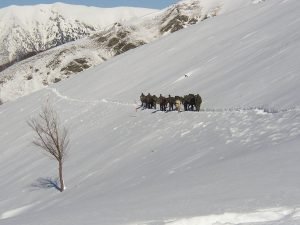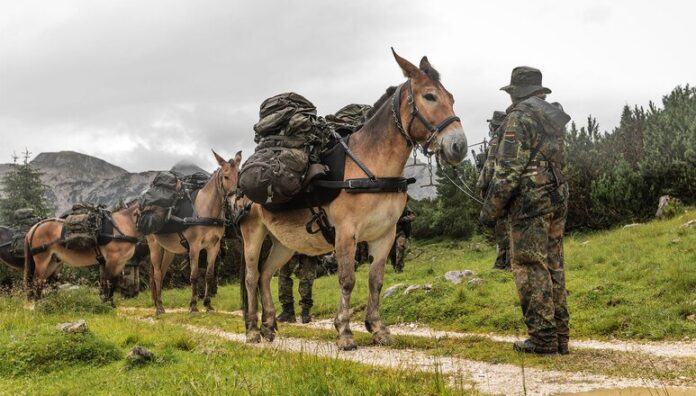In an era dominated by new technologies and cutting-edge methods of transportation, it may be hard to imagine that there are military units that still rely on the steadfast support of animals like mules, horses or donkeys. The German Mountain Infantry Brigade, the last brigade in the Bundeswehr that works with pack animals, offers convincing evidence of the continued relevance and indispensable role that these animals play in missions and operations in mountainous terrains.
Master Sergeant Matthias Havel joined the Mountain Infantry Brigade in 1999. Initially drawn to the Brigade thanks to a love of the mountains and a motivation to work in physically challenging environments, he sees his assignment to the pack animal company as a ‘coincidence that he has never regretted’.
“Our main role is to fulfil the infantry role in extreme environmental conditions, like mountainous regions and cold weather,” he explains. “We support the fighting units in demanding terrains when trucks or helicopters cannot back our troops.”
The German Mountain Infantry Brigade was established during the First World War and initially recruited civil alpinists. At that time, the mules, donkeys and horses were employed as the primary means of transportation for soldiers and equipment. Although motor vehicles have become the main means of transport for troops, according to Master Sergeant Matthias, this change has not decreased the relevance of animals for the Brigade’s missions. “Pack animals have been a mainstay of logistics in difficult terrains and alpine climates,” he explains.

Cold, extreme weather and difficult topography are not the only challenges for the Brigade. With four-legged team members involved, Master Sergeant Matthias’ work includes an extra layer of responsibility in providing for the animals. “Every leader has to care about their subordinate soldiers, but we, on top of that, have to care about our animals. We have to be physically fit to lead them in tough conditions and demonstrate enough empathy and expertise as every mule has its own character and does not work every day in the same way. This means that the leader of the pack animal has to remain flexible and be able to adapt to their mule when needed.”
Besides the usual infantry activities, like combat training or shooting, the unit’s everyday routine also includes checking the mules for injuries, mucking out the stables and marching in the mountains two-to-four times a week to train the animals (and humans) in the terrain. The unit also trains to lash load to the mules with special cargo saddles, and to accustom the animals to the noises of battle.
For this reason, the Brigade’s mules are selected very carefully. “We choose them based on their height and good nature,” says Master Sergeant Matthias. “The ideal height for a mule is 1.5 metres at the withers so that they are big enough to carry the necessary weight but it is not too difficult to saddle them. Overall, mules are extremely strong, hard-working and modest animals, which is a big advantage for these tasks.”
Working with any team in adverse conditions can create strong bonds and friendships, and the unit’s relationship with its animals is no exception. “My mule is like a human comrade and a good friend. Working with it gives me balance and peace of mind,” Master Sergeant Matthias shares. “It is always fascinating to see how the pack animal leader is connected to their mule. Sometimes when we are on a march in the mountains, it is very hot and exhausting. We take a break and you can see how the pack animal leader looks after their animal like their own child. They encourage their mules, give them water and are so dedicated to the animal that they often take care of it before themselves.”
To be able to provide for the animals, every member of the unit has to participate in a special six-week pack animal training course, which supplements the regular basic and special training sessions for new infantry members. During this time, they learn skills for working with mules and horses, and gain an understanding of diseases that may affect the animals and basic first aid to treat them.
In the past, the Brigade has deployed to missions in various settings, ranging from Afghanistan to Kosovo and, most recently, to Norway. “When we deploy, we usually use local pack animals that are more accustomed to the environment and climate,” says Master Sergeant Matthias. “While on missions in Germany, we mostly rely on mules, but when we trained Special Forces for their mission in Afghanistan, for example, using donkeys was much preferred as they were easier to acquire in that country. Last December, four donkeys joined our team so that we can learn how to operate together better.”

Master Sergeant Matthias believes pack animals in warfare will continue to be essential in the future. “In my opinion, even in the future, there will be a need for pack animals. These animals have proven themselves over thousands of years and there will always be missions where you cannot use mechanical support for the troops. They are a great addition to every mechanical supply system, allowing us to do our job in any weather, day and night.”
For Master Sergeant Matthias, being part of NATO is an opportunity to contribute to the mission of the Alliance and to exchange experiences with soldiers from other countries who work with pack animals, like some units from the United States, as well as troops who do not regularly operate with mules or horses. “We gladly share our expertise with other NATO members about what our work entails. It makes us proud that our unit is not only a support team with animals but a group of fully skilled mountain infantry troops ready to assist the Alliance in the most extreme and challenging conditions.”
Source: nato.int

